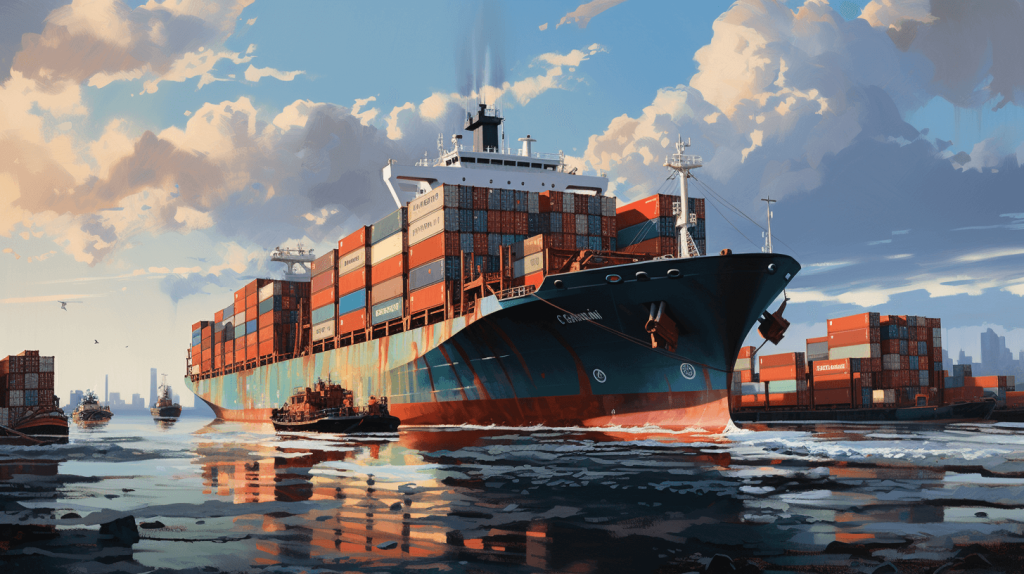
Globalization has ushered in an era of unprecedented accessibility to goods and technology worldwide. From supermarket shelves stocked with products from diverse countries to the global assembly of iconic gadgets like the iPhone, the reach of globalization is evident everywhere.
This article delves into the transformative impact of globalization on trade, technology, and shipping, focusing on the visionary truck driver Malcolm McLean, who revolutionized the global shipping industry through containerization.
Table of Contents
Global Supermarkets: A Showcase of Globalization

A Global Gastronomic Adventure
Supermarkets have become a melting pot of flavors, inviting customers on a gastronomic journey across borders. With the influence of globalization, a wide variety of food items now grace the shelves, representing the culinary richness of different countries.
Orange juice from China offers a refreshing tang, nuts from India provide an aromatic crunch, swordfish from Japan promises a delightful seafood experience, Czechoslovakian lagers provide a taste of European brewing traditions, and an array of European cheeses tantalize taste buds with their diverse textures and flavors.
Redefining Culinary Convenience
Once considered a luxury reserved for the adventurous and the affluent, exotic foods are now available to the average consumer. Globalization has paved the way for the seamless movement of goods, making it possible for distant delicacies to be a part of our everyday lives.
Consumers no longer need to embark on arduous journeys to experience the flavors of far-off lands; instead, they can easily savor these delicacies during a quick supermarket visit. This newfound culinary convenience has transformed how people shop for and enjoy food, creating a global dining experience in the comfort of their homes.
Broadening Palates and Enhancing Experiences
The globalization of food products has opened doors to a world of tastes and textures, enriching people’s lives globally. Exposure to diverse culinary delights has broadened palates, encouraging individuals to embrace new flavors and cuisines enthusiastically.
As consumers explore these gastronomic treasures, they gain a deeper understanding of the cultural significance of various dishes and ingredients. This experiential learning transcends mere consumption; it fosters a greater appreciation for the nuances of different cuisines, forging connections between people from disparate backgrounds.
Cultural Exchange and Global Harmony
Food has always been a powerful medium for cultural exchange, and globalization has amplified its impact. As hubs of diverse products, supermarkets facilitate a profound cultural exchange by allowing people from different cultures to connect through their shared love for food.
As individuals sample dishes from foreign lands, they immerse themselves in distant cultures’ culinary traditions and stories. This exposure nurtures empathy, understanding, and acceptance, contributing to the promotion of harmony on a global scale.
Embracing and celebrating culinary diversity creates a world where differences are appreciated and connections are strengthened.
Technological Globalization: The iPhone and Beyond

The iPhone – A Global Collaborative Effort
The iPhone’s journey from concept to reality is a testament to the power of technological globalization. Designed in the bustling tech hub of California’s Silicon Valley, it is a product of cooperation and expertise from around the globe.
Manufacturers in China, Japan, Germany, South Korea, and the United States contribute essential components, while assembly lines in multiple countries bring the iPhone to life. This seamless international collaboration ensures efficiency and fosters a global sense of ownership over this revolutionary device.
The iPhone’s design incorporates diverse expertise and perspectives, from the innovative touch screen to the advanced processors. It represents how technology transcends geographical boundaries, uniting minds across cultures to create devices that reshape how we interact with the world.
Global Technology Networks: Driving Innovation Across Industries
Beyond the iPhone’s success, global technology networks drive innovation across various sectors. In microchips, semiconductor companies collaborate across borders, exchanging knowledge and advancements.
This collaboration allows for the continuous development of faster, more efficient, and more powerful chips that underpin smartphones and a wide range of modern devices, from computers to artificial intelligence systems.
Open-source projects and global teams collaborate in software development to create cutting-edge applications and platforms. This collaborative approach empowers developers to access resources, expertise, and diverse perspectives, resulting in robust and widely adopted software solutions.
Global technology networks are also revolutionizing the healthcare, renewable energy, and transportation industries. Sharing medical research and telemedicine solutions has improved healthcare accessibility in remote areas.
Advancements in renewable energy technologies have been made possible through international partnerships and knowledge exchange, paving the way for a more sustainable future. In the transportation sector, global cooperation on electric vehicles and smart mobility solutions has the potential to reshape urban landscapes and reduce carbon emissions.
Empowering a Connected World
The widespread availability of technology worldwide has become a transformative force, empowering individuals, businesses, and governments globally. In the digital age, communication knows no borders.
The proliferation of smartphones and internet connectivity has enabled instant and seamless communication across continents, bridging time zones and cultures. This connectedness fosters collaboration, knowledge-sharing, and cultural exchange, enriching lives and promoting mutual understanding.
Technology’s global reach has also revolutionized education. Online learning platforms and digital resources break down barriers to education, making knowledge accessible to individuals regardless of their location or socioeconomic background.
This democratization of education opens doors to new opportunities and nurtures a skilled and informed workforce that drives economic growth and social development.
Moreover, technology has catalyzed advancements in healthcare, bringing medical expertise and solutions to underserved regions. Telemedicine and mobile health applications enable remote diagnosis and treatment, improving healthcare access and outcomes.
The dissemination of medical knowledge and research across borders has the potential to save lives and enhance public health on a global scale.
Containerization: Malcolm McLean’s Shipping Revolution

Amid the Great Depression: Malcolm’s Visionary Idea
Identifying Inefficiencies: The Break Bulk Shipping Process
During the Great Depression, Malcolm McLean experienced the inefficiencies plaguing the traditional break bulk shipping process. Cargo handling involved the manual loading and unloading of each piece, a labor-intensive and time-consuming task. The lack of standardization led to delays, increased costs, and a significant burden on labor.
Recognizing these challenges, Malcolm saw an opportunity to revolutionize the shipping industry and sought a solution to optimize operations and drive economic growth and global connectivity.
Malcolm McLean’s Vision: The Birth of Containerization
Driven by his keen understanding of the shipping industry’s pain points, Malcolm McLean conceived the idea of containerization. His vision was to introduce standardized, stackable containers that could seamlessly be loaded onto ships, trucks, and trains.
Each container would hold significant cargo, allowing more efficient loading and unloading processes.
This radical concept of containerization aimed to eliminate the need for individual handling of cargo pieces. By implementing this system, Malcolm sought to drastically reduce loading and unloading times, leading to increased productivity, cost savings, and improved logistics.
Revolutionizing Global Trade: The Potential of Containerization
Malcolm McLean’s visionary concept had the potential to revolutionize the shipping industry and streamline global trade. The introduction of standardized containers enabled cargo to be efficiently loaded and transported across various modes of transportation without the need for constant manual handling.
Containerization proved to be a game-changer for international trade, transforming ports into bustling centers of commerce and opening up new business possibilities. The standardization of containers fostered a more interconnected world, facilitating the movement of goods across continents with unprecedented ease and speed.
Moreover, containerization brought about cost efficiencies, reducing transportation costs and making goods more accessible to a global market. This facilitated the growth of international trade, leading to economic development and cultural exchange between nations.
Overcoming Hurdles: Malcolm’s Perseverance
Challenging the Status Quo: Skepticism Surrounding Containerization
As Malcolm McLean introduced the concept of containerization, he encountered skepticism from established industry experts who questioned the feasibility and practicality of his ambitious idea.
The prevailing break bulk shipping process had long been the norm, and the idea of standardized, stackable containers seemed unconventional and daring.
Critics raised concerns about the adaptability of ports and infrastructure to accommodate containerized cargo. They questioned the economic viability and potential disruption to existing operations. Yet, amid this skepticism, Malcolm remained undeterred, recognizing the transformative potential of containerization in streamlining global trade.
Perseverance and Ambition: From Small Trucking Business to Shipping Giant
Undeterred by the naysayers, Malcolm McLean pressed forward with his vision for containerization. He was determined to prove that this radical concept could revolutionize the shipping industry and unlock new efficiencies in cargo handling.
With sheer perseverance and ambition, Malcolm expanded his small trucking business, laying the groundwork for a shipping empire. He sought to create a comprehensive system where standardized containers could seamlessly move between ships, trucks, and trains, optimizing the logistics chain.
Through strategic acquisitions and partnerships, Malcolm steadily built a shipping empire that could support the implementation of containerization on a large scale. His vision was not just about improving his own business but transforming the industry for the greater good.
A Crucial Backing: The Citibank Loan that Made it Possible

One of the most pivotal moments in Malcolm McLean’s journey came when he secured a crucial loan from an enterprising Citibank vice president, Eugene Meyer. Recognizing the potential of containerization and Malcolm’s unwavering commitment, Meyer took a calculated risk and provided the financial backing necessary to bring this ambitious dream to life.
With this crucial loan, Malcolm had the means to develop the necessary infrastructure, design standardized containers, and launch the first container ship. The loan was a catalyst that propelled containerization from an audacious idea to a concrete reality.
The Birth of Containerization: The Ideal X
The Ideal X: A Pioneering Voyage
The Ideal X’s maiden voyage was a groundbreaking moment that reshaped the global trade landscape. As the first container ship, it was a physical manifestation of Malcolm McLean’s visionary containerization concept. Departing from Port Newark, it carried 58 containers, each securely stacked on its deck, ready to usher in a new era in shipping.
This pioneering voyage demonstrated the viability and practicality of containerization. By eliminating the need for individual cargo handling, the Ideal X showcased the potential for seamless transfers between ships, trucks, and trains.
The success of this voyage paved the way for the widespread adoption of standardized containers and revolutionized the way goods were transported across continents.
Containerization: A Game-Changer in Trade and Logistics
Containerization proved to be a game-changer in international trade and logistics. The introduction of standardized containers offered numerous benefits that transformed the efficiency and cost-effectiveness of transporting goods.
By standardizing the size and shape of containers, it became possible to use specialized equipment for loading and unloading, streamlining the entire process. This standardization also facilitated the smooth transfer of containers between various modes of transportation, reducing delays and optimizing supply chains.
Furthermore, containerization significantly reduced the time required to transport goods. Once congested with break bulk cargo handling, ports became more efficient using container terminals—the standardized containers allowed for quicker loading and unloading, ensuring faster turnaround times for vessels and trucks.
Transforming Ports and Global Commerce
One of the most profound impacts of containerization was its transformation of ports into bustling centers of global commerce. Previously constrained by the slow and labor-intensive break bulk shipping process, ports became hubs of efficiency and productivity.
Container terminals, equipped with modern cranes and handling equipment, enabled rapid movement of containers on and off ships. This heightened efficiency attracted increased trade and business opportunities, fueling economic growth in port cities and regions.
Containerization also expanded global trade, enabling businesses to reach new markets and customers worldwide. The ease of transporting goods across continents opened up new possibilities for international commerce and cultural exchange.
Conclusion
The impact of globalization on our lives is evident in the supermarket aisles filled with international goods and the technologies that connect us across borders. However, at the heart of this revolution stands Malcolm McLean, whose pioneering concept of containerization transformed global trade and empowered a more interconnected and accessible world. As we enjoy the fruits of globalization, let us not forget the visionary who made it possible.






